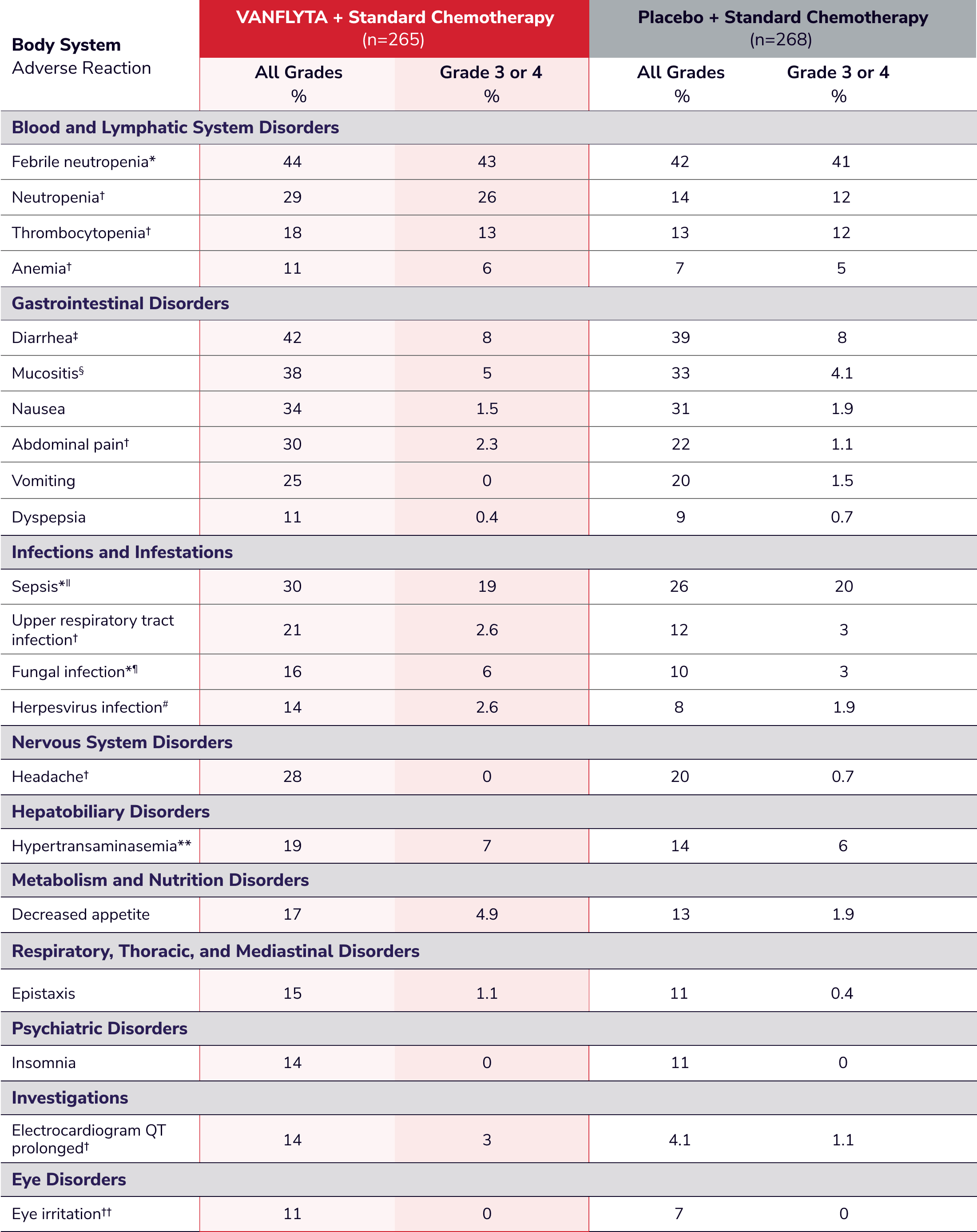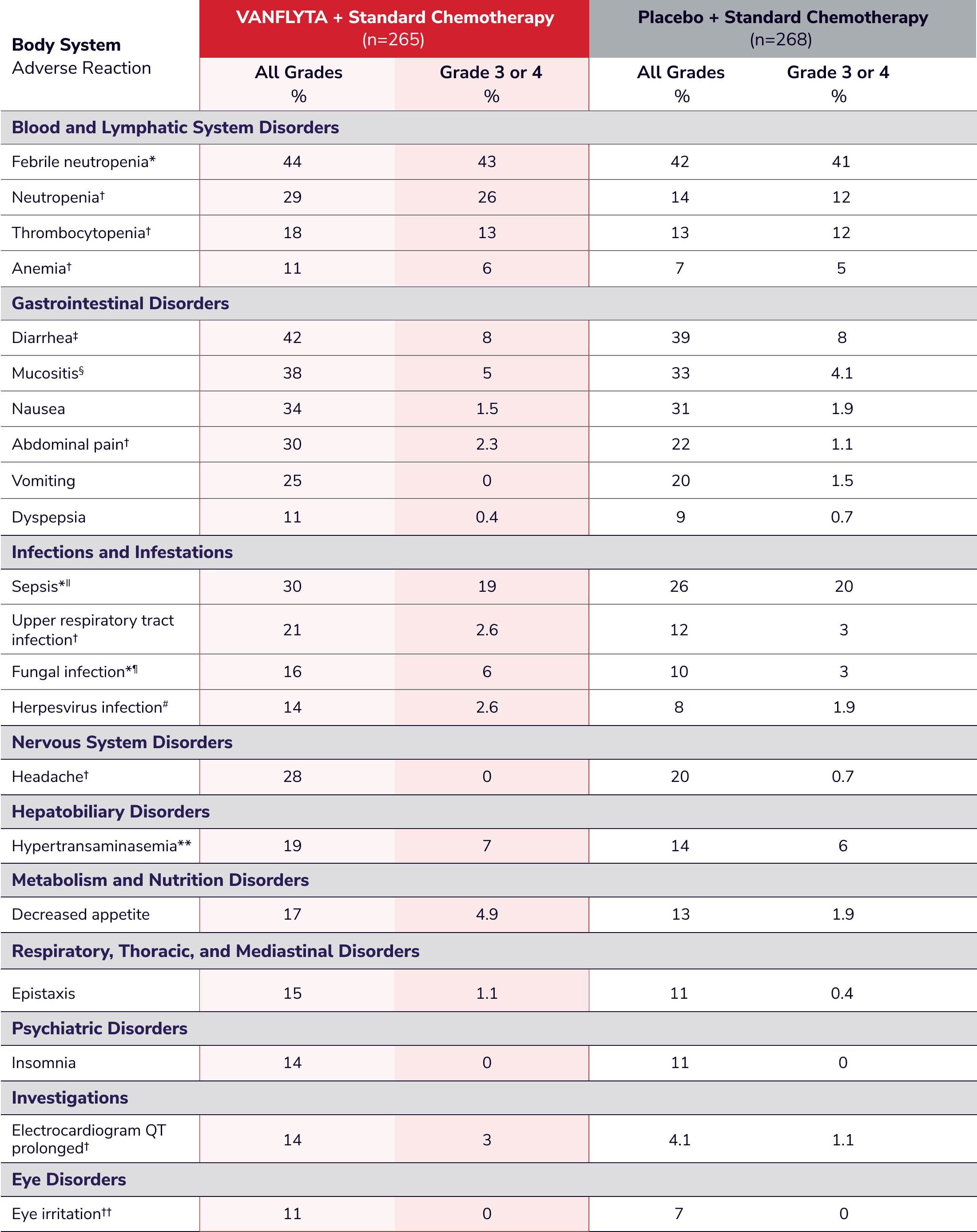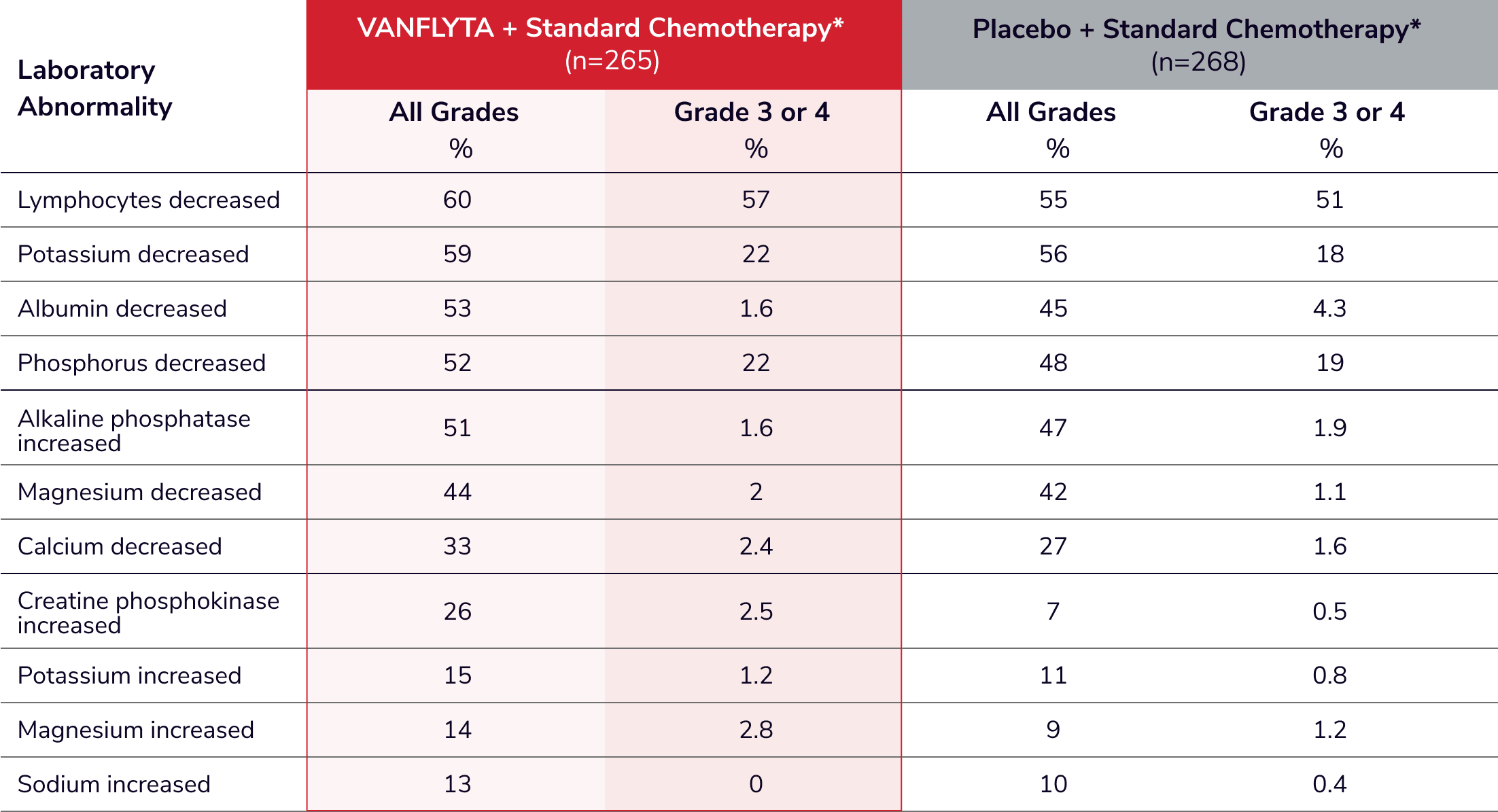For treatment-eligible patients with newly diagnosed FLT3-ITD+ AML Start and stay with VANFLYTA—The only FLT3 inhibitor indicated for INDUCTION, CONSOLIDATION, AND MAINTENANCE1-3* *Please see Full Indication, including Limitations of Use, below.
- Contraindicated in patients with severe hypokalemia, severe hypomagnesemia, long QT syndrome, or in patients with a history of ventricular arrhythmias or torsades de pointes1
- QT Prolongation, Torsades de Pointes, and Cardiac Arrest: Monitor electrocardiograms and levels of serum electrolytes. Reduce, interrupt, or permanently discontinue VANFLYTA as appropriate1
- Embryo-Fetal Toxicity: VANFLYTA can cause fetal harm. Advise females of reproductive potential and males with female partners of reproductive potential of potential risk to a fetus and to use effective contraception1
The following safety profile is a partial presentation of risks associated with VANFLYTA. Please see Full Prescribing Information, including Boxed WARNINGS, and Medication Guide.1
reactions
ADVERSE REACTIONS (≥10%) IN PATIENTS RECEIVING VANFLYTA (WITH A DIFFERENCE BETWEEN ARMS OF ≥2% COMPARED TO PLACEBO) IN THE CLINICAL TRIAL1


*Including fatalities.1
†Includes other related terms.1
‡Diarrhea includes colitis, diarrhea, enteritis, enterocolitis, gastroenteritis, and neutropenic colitis.1
§Mucositis includes anal inflammation, anal ulcer, anorectal discomfort, aphthous ulcer, laryngeal inflammation, laryngeal pain, mucosal inflammation, edema mucosal, esophageal pain, esophageal ulcer, esophagitis, oral blood blister, oral disorder, oral mucosal erosion, oral mucosal blistering, oral mucosal erythema, oral pain, oropharyngeal pain, pharyngeal inflammation, proctalgia, proctitis, stomatitis, tongue ulceration, and vaginal ulceration.1
||Sepsis includes acinetobacter infection, bacteremia, bacterial sepsis, corynebacterium bacteremia, device-related bacteremia, device-related sepsis, enterobacter sepsis, enterococcal bacteremia, enterococcal sepsis, escherichia bacteremia, escherichia sepsis, klebsiella bacteremia, klebsiella sepsis, neutropenic sepsis, pseudomonal bacteremia, pulmonary sepsis, sepsis, septic shock, staphylococcal bacteremia, staphylococcal infection, staphylococcal sepsis, stenotrophomonas sepsis, streptococcal sepsis, and streptococcal bacteremia.1
¶Fungal infection includes aspergillosis oral, aspergillus infection, bronchopulmonary aspergillosis, candida infection, candida sepsis, fungal infection, fungal sepsis, fungal skin infection, fusarium infection, gastrointestinal candidiasis, hepatic infection fungal, hepatosplenic candidiasis, lower respiratory tract infection fungal, mucormycosis, oral candidiasis, oral fungal infection, oropharyngeal candidiasis, systemic candida, systemic mycosis, tinea cruris, and vulvovaginal candidiasis.1
#Herpesvirus infection (including fatal events) include disseminated varicella zoster virus infection, genital herpes, herpes simplex, herpesvirus infection, herpes zoster, oral herpes, and varicella zoster virus infection.1
**Hypertransaminasemia includes alanine aminotransferase increased, aspartate aminotransferase increased, transaminases increased, hepatic enzymes increased, and hypertransaminasemia.1
††Eye irritation includes dry eye, eye inflammation, eye irritation, eye pain, eye pruritus, foreign body sensation in eyes, keratitis, and ulcerative keratitis.1
Abnormalities
Select Laboratory Abnormalities (≥10%) That Worsened from Baseline in Patients (with a Difference Between Arms of ≥2% Compared to Placebo) IN THE CLINICAL TRIAL1


*The denominator used to calculate the rate varied from 199 to 260 in VANFLYTA + chemotherapy and from 187 to 267 in placebo + chemotherapy based on the number of patients with a baseline value and at least one post-treatment value.1
- Serious adverse reactions in ≥5% of patients who received VANFLYTA plus chemotherapy were: febrile neutropenia (11%). Fatal adverse reactions occurred in 10% of patients who received VANFLYTA plus chemotherapy, including sepsis (5%), fungal infections (0.8%), brain edema (0.8%), and one case each of febrile neutropenia, pneumonia, cerebral infarction, acute respiratory distress syndrome, pulmonary embolism, ventricular dysfunction, and cardiac arrest1
-
With VANFLYTA, 34% of patients experienced a dose
interruption due to ARs, 19% had a dose reduction, and 20%
discontinued
- Adverse reactions which required dosage interruption in ≥2% of patients in the VANFLYTA arm included neutropenia (11%), thrombocytopenia (5%), and myelosuppression (3%)
- Adverse reactions which required dosage reductions in ≥2% of patients in the VANFLYTA arm were neutropenia (9%), thrombocytopenia (5%), and electrocardiogram QT prolonged (4%)
- The most frequent (≥2%) adverse reaction which resulted in permanent discontinuation in the VANFLYTA arm was sepsis (5%)
The VANFLYTA REMS
VANFLYTA is available only through a restricted distribution program under a Risk Evaluation and Mitigation Strategy (REMS) called the VANFLYTA REMS because of the serious risk of QT prolongation, torsades de pointes, and cardiac arrest.1
The VANFLYTA REMS includes the following:
- Prescribers must be certified in the VANFLYTA REMS by enrolling and completing training.
- Prescribers must counsel patients receiving VANFLYTA about the risk of QT prolongation, torsades de pointes, and cardiac arrest, and provide patients with a Patient Wallet Card.
- Pharmacies that dispense VANFLYTA must be certified with the VANFLYTA REMS and must verify prescribers are certified through the VANFLYTA REMS.
ENROLL TODAY to prescribe VANFLYTA
at VANFLYTAREMS.com or by calling 1-855-212-6670
VANFLYTA is indicated in combination with standard cytarabine and anthracycline induction and cytarabine consolidation, and as maintenance monotherapy following consolidation chemotherapy, for the treatment of adult patients with newly diagnosed acute myeloid leukemia (AML) that is FLT3 internal tandem duplication (ITD)–positive as detected by an FDA-approved test.
Limitations of Use: VANFLYTA is not indicated as maintenance monotherapy following allogeneic hematopoietic stem cell transplantation (HSCT); improvement in overall survival with VANFLYTA in this setting has not been demonstrated.
AML=acute myeloid leukemia; AR=adverse reaction; FLT3=FMS (feline McDonough sarcoma)–like tyrosine kinase 3; HSCT=hematopoietic stem cell transplantation; ITD=internal tandem duplication.
1. VANFLYTA [package insert]. Basking Ridge, NJ: Daiichi Sankyo, Inc; 2024. 2. XOSPATA [package insert]. Northbrook, IL: Astellas Pharma US, Inc; 2022. 3. RYDAPT [package insert]. East Hanover, NJ: Novartis Pharmaceuticals Corp; 2023.

